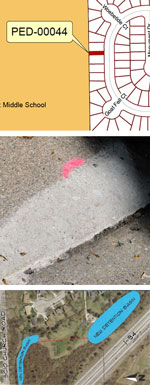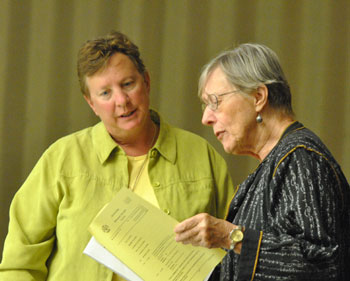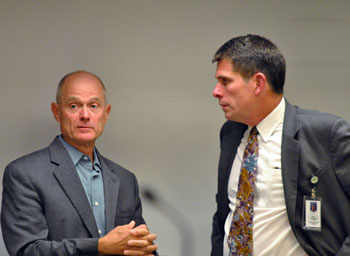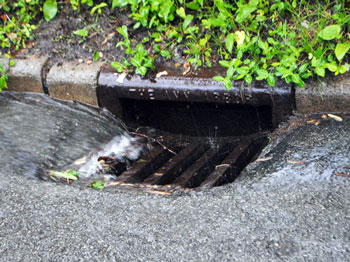City crews working hard to clear storm drains. Rain in the forecast for tomorrow. [photo] [At last night's city council meeting, city administrator Steve Powers encouraged residents to help out with clearing storm drains.] [map of catch basin locations]
Stories indexed with the term ‘flooding’
Sidewalks: Repair, Build, Shovel
Local government doesn’t get more pedestrian than sidewalks.

Top: Example of a cross-lot walkway, leading from street to school. Middle: Sidewalk that was cut flush funded by the city’s sidewalk repair millage. Bottom: Recommended detention ponds in Eisenhower Park near the proposed Scio Church sidewalk.
Yet these existing and future slabs of concrete are themselves a constant topic of confusion and controversy: Who’s responsible for repairing the busted slab in front my house? Who’s supposed to shovel snow off the sidewalk in the winter?
Sidewalks also connect up to other equally important if also dull components of local governance – like stormwater management and public art.
So here’s a quick rundown of some specific sidewalk-related issues that the Ann Arbor city council will be considering.
The council’s agenda for Monday, Oct. 7, includes an item on the definition of sidewalks. If an existing walkway meets the definition of a “sidewalk,” then the city bears responsibility for its repair for the duration of the sidewalk repair millage. All other things being equal, the adjacent property owner would be responsible for snow removal in the winter.
The Oct. 7 agenda item focuses on walkways that aren’t really on the “side” of anything – walkways that connect a street to a park or school, or that connect two parallel streets. The city calls them “cross-lot” walkways. If such walkways were added into the definition of “sidewalk” – as the city council is contemplating – then the city would be responsible for repair. That’s a result welcomed by property owners. But it would put the burden for snow removal on those property owners – a less welcome result. That was the sentiment that led the council to postpone final consideration of a change to the definition of “sidewalk” three months ago, on July 1, 2013.
So on Oct. 7, the council will be asked to consider a different approach to that definitional change – one that would allow the so-called “cross-lot” paved pathways to qualify as sidewalks under the city’s ordinance, but not trigger a winter maintenance requirement for adjacent property owners.
The fresh look would mean that the council’s possible action on Oct. 7 would be considered only an initial approval of the ordinance change. Final enactment of the change would require a second vote at a subsequent council meeting. If approved, the ordinance would allow cross-lot paths to be repaired under the city’s sidewalk repair program – funded through the five-year millage approved by Ann Arbor voters in November 2011. That program is noticeable to residents in the form of pink markings that appear on sidewalk slabs – an “R” for replace and a “C” for cutting an out-of-alignment section so that it lines up flush with the next slab.
The millage can pay for repair or replacement of existing slabs of sidewalks, but not for the construction of new sidewalks. So that millage money isn’t available to build a new stretch of sidewalk along the south side of Scio Church Road (or to fill in a smaller gap on the north side) – a section of sidewalk that residents have petitioned the city to build. The petition for a sidewalk there is based on several considerations, including a desire to connect to amenities west of I-94, like the Ice Cube, Wide World of Sports and the Ann Arbor District Library’s Pittsfield branch. It’s also seen as a pedestrian safety issue, because the lack of a sidewalk on one side of the road could induce pedestrians to cross the road at places where motorists don’t expect pedestrians to cross.
The city council authorized $15,000 of general fund money for the study of alternatives along that stretch – alternatives that were presented at a meeting held on Sept. 18 at Lawton Elementary School and attended by about two dozen people. Next up for the city council, likely on Oct. 21, will be a request for a design budget, so that costs of the project can be estimated with more precision.
Among the alternatives that were considered, but not pursued in much detail, was construction of a pathway through Eisenhower Park. That’s where the Washtenaw County water resources commissioner is now recommending that a pair of detention ponds be constructed – to help mitigate overland flooding in the area. That recommendation was presented to a group of about 80 neighbors on Sept. 30 – also held at Lawton Elementary School.
And a fence that that might need to be constructed along the proposed Scio Church sidewalk – to prevent people from falling down the steep incline – received a glancing mention at a recent meeting of the Ann Arbor public art commission. A proposal to fund a public art project that would be integrated into the fence was tabled by the commission at its Sept. 25, 2013 meeting. [Full Story]
7th & Madison
Heavy rain on 7th at Madison. Very wet bike rider stops and cleans street drain. Doesn’t notice admiring watchers. Thanks, H. D.
Ashley & Felch
A look at some of the fun at Ashley & Felch in earlier today. Observe UPS van. [link] (61 MB file)
S. Fifth Avenue
UM: North Quad Flooding
The Michigan Daily provides an update and photos from the extensive flooding at North Quad, caused by a broken joint pipe in the building’s fire suppression system. The flooding affected student residences and classrooms – about 100 students were moved to other quarters. [Source]
County Gets Info on Flooding, Shares Options
A meeting last week at Lawton Elementary School, in southwest Ann Arbor, fell the day before the one-year anniversary of significant overland flooding in the neighborhood. The flooding resulted from heavy rains last year on March 15, 2012. Last week’s meeting followed an earlier one held on Jan. 29, 2013.
The meetings are part of a study of the Upper Malletts Creek watershed, being conducted by the office of the Washtenaw County water resources commissioner under an agreement with the city of Ann Arbor. The year-long study is supposed to culminate in a final report due to the Ann Arbor city council in February 2014. Water resources commissioner Evan Pratt was on hand at the meeting, along with other members of the project team.
In response to direction from a citizens advisory group that’s been formed for the project, the team used the March 14 meeting to introduce residents to the basic toolkit for stormwater management techniques. The general stormwater management practices described at the meeting – without trying to analyze which solutions might be appropriate for specific locations in the area – ranged from increasing the number of catch basins in streets to the construction of underground detention facilities.
At least 60 residents attended the meeting, and seemed generally receptive to the idea that some money might actually be spent on infrastructure projects to reduce flooding in their neighborhood: “If you want me to sign up for you breaking up my street and putting [stormwater management infrastructure] in there, just give me a consent form and I will sign it tonight!”
The project team is also still in a phase of gathering information about specific experiences that residents have had with past flooding problems. And the same technology platform – an online mapping tool – can be used by residents for logging future flooding events. For help in using a smart-phone app, one attendee volunteered her grandson “for rent” to other residents. Members of the project team also indicated they welcomed information submitted in any format – including letters, face-to-face conversation and phone calls.
But it was a missing follow-up phone call – expected from one resident who’d attended the first meeting on Jan. 29 – that indicated some continuing frustration about the city’s footing drain disconnection (FDD) program. The frustrated resident’s experience had been that after an FDD program sump pump was installed in his basement, he’d started having problems with a wet basement – problems he hadn’t experienced before. Project manager Harry Sheehan, with the county water resources commissioner’s office, extended an apology for the missed communication and an offer to arrange a site visit.
The FDD program removes a building’s footing drain connection to the sanitary sewer system and redirects that stormwater flow to the system designed to handle it – the stormwater system. The FDD program, which has been somewhat controversial, is not the focus of the Upper Malletts Creek study. But residents got an assurance that the additional volume of rainwater that goes into the stormwater system – as a result of the FDD program – would be accounted for in all the modeling that’s done as part of this study. [Full Story]
City Council Punts on Several Agenda Items
Ann Arbor city council meeting (Sept. 17, 2012): The council’s initial agenda, released on Wednesday before the Monday meeting, was relatively light. But by the time the council had approved that agenda to start the meeting, it had grown considerably heavier.

Left to right: Sandi Smith (Ward 1) and former councilmember and planning commissioner Jean Carlberg. (Photos by the writer.)
Five significant items had been added: (1) a proposal to suspend temporarily the footing drain disconnection program in one area of the city; (2) a proposal to waive temporarily the city’s living wage requirement for certain nonprofits; (3) a proposal to establish a sidewalk gap elimination program; (4) a resolution on dealing with proceeds of city-owned land sales that competed with one already on the agenda; and (5) reconsideration of allocating $60,000 for a transit study – funding that the council had rejected at its previous meeting.
The first two items were added on Friday, Sept. 14. The second two were added the day of the meeting (Sept. 17), with the fifth item added at the council table. Of the added items, the council approved only one – to suspend temporarily the footing drain disconnect program. The rest were postponed, withdrawn or voted down.
Postponed was the resolution added by Mike Anglin (Ward 5) to establish a committee of city officials and 10 residents – two from each ward, to be selected by councilmembers for respective wards – to address the issue of city-owned parcels in downtown Ann Arbor. The citizen committee to be established by Anglin’s resolution would study the available options for use of proceeds from the sale of downtown city properties.
Also postponed was the resolution that Anglin’s proposal was essentially challenging, which was brought forward by Sandi Smith (Ward 1). Smith wants to direct the proceeds from city-owned land sales to the city’s affordable housing trust fund. Her idea – which she first floated to her council colleagues in an email written in late August – enjoyed the support of nonprofits, as well as the Ann Arbor Downtown Development Authority board and the Washtenaw County board of commissioners.
While Anglin’s resolution was postponed until Oct. 1, Smith’s was referred to the council’s budget committee and postponed until the council’s Oct. 15 meeting.
Also postponed was a requested $60,000 contribution to fund further study of a transportation connector – for the corridor running from US-23 and Plymouth southward along Plymouth to State Street and farther south to I-94. The outcome of this phase is to identify a preferred choice of technology (e.g., bus rapid transit, light rail, etc.) and the location of stations and stops. The council had voted down the proposal at its Sept. 4 meeting, but it was brought back for reconsideration on Sept. 17, only to be postponed until Oct. 15. The $60,000 is meant to be the city’s share of a $300,000 local match for a $1.2 million federal grant that has already been awarded.
Withdrawn was the proposal to waive a requirement of the city’s living wage ordinance for those nonprofits that receive funding from the city to deliver human services. The ordinance has a provision for a hardship waiver, but states that a nonprofit must submit a plan for eventual compliance within three years. No nonprofits had submitted such plans, meaning that the council’s resolution would have amounted to an attempt by the council to amend the living wage ordinance through a simple resolution, which it cannot do. When the council reached the item on the agenda, it was withdrawn, with an indication that an ordinance revision would be brought forward to a future meeting.
Also at the Sept. 17 meeting, the council heard about an item related to nonprofit funding for human services that will be brought forward on Oct. 1: a request to continue the two-year pilot program for coordinated funding. That news came during a presentation from Mary Jo Callan, head of the city/county office of community and economic development.
Voted down was a plan to initiate a 5-year program to eliminate sidewalk gaps in the city. Councilmembers voting against the resolution pointed to the fact that the city’s non-motorized transportation plan takes a comprehensive approach to identifying such gaps. They feared that people might mistakenly believe that certain gaps would necessarily be filled through this program, and raised concerns about equity. The resolution sought to identify independent funding sources to pay for such projects – the city’s strategy in the past has been to levy special assessments on owners of property adjoining the sidewalks.
The footing drain disconnect program was the only one of the late additions to the agenda on which the council took final action. In the general vicinity of the Lansdowne neighborhood, where some houses have already had sump pumps installed as part of the disconnect program, residents have reported that during heavy rains, the overland stormwater flows and the sheer volume of water in the city’s stormwater system prevent sump pumps from being effective. At an Aug. 22 neighborhood meeting, residents had called for a moratorium on the program. That’s essentially what the council’s resolution did.
Flooding was also a topic included in other council business that had been placed on the agenda through the regular agenda-setting process. The council approved an update to the city’s hazard mitigation plan. It will allow the city to receive already-approved federal funds for demolishing two out-buildings located in the floodway at the city-owned 721 N. Main property.
Also related to emergency preparedness, the city council authorized the purchase of a light rescue vehicle that can be used by firefighters to respond to medical calls. Because its staffing requirement is just two firefighters instead of three, the use of the vehicle would allow response to medical calls without diminishing as much of the department’s response capability for fire calls.
The council also gave final approval to rezoning of an Eden Court property to public land. [Full Story]
Council Meeting: Floods, Fires, Demolition
Ann Arbor city council meeting (Aug. 9, 2012) Part 2: Ballot initiatives for the Nov. 6, 2012 election – two about parks and one on public art – were the dominant theme of the council’s meeting. Those are covered in Part 1 of the meeting report.

From left: Mayor John Hieftje and city administrator Steve Powers before the start of the Aug. 9, 2012 council meeting.
But the council transacted several other pieces of business as well, some of which could be grouped into the general thematic pattern of land and property use. Most obviously connected to land use was the council’s initial approval of a rezoning request in connection with an expansion proposal from Knight’s Market, at the corner of Miller and Spring streets. The rezoning would allow a house to be converted into a bakery. It would also allow for eventual approval of a site plan to build a 1,200-square-foot addition to the existing grocery store and to expand, reconfigure, and improve the existing parking lot.
The council also passed a resolution to deal with an issue stemming, in part, from land use decisions made decades ago that resulted in residential development in the area of the Malletts Creek drainage district. Recently, residents in the area have been faced with severe localized flooding. The council’s resolution directed staff to start negotiations with the Washtenaw County water resources commissioner to identify “opportunities for stormwater conveyance and stormwater quality improvement in the area of the Malletts Creek drainage district.”
Related at least tangentially to land use at the level of a specific parcel was a resolution the council passed establishing the property at 317 Maynard in downtown Ann Arbor as an industrial development district. The move sets the stage for an expected application from the future tenant of the space, owned by First Martin Corp., for a tax abatement that would be worth around $85,000. The tenant is Barracuda Networks.
And the council took another step in implementing a strategy to eliminate blight. The city had previously set aside funds that could be used to demolish blighted buildings – if the city is unsuccessful in getting property owners to demolish them. The council’s action last Thursday authorized the city to sign contracts with four different companies to do such demolition work on an as-needed basis. It was announced at the meeting that the houses on North Main – at the site of the planned Near North affordable housing project – will likely be among the first to be demolished under the contracts authorized by the council.
To the extent that transportation systems have an impact on future land use, another item related to land use was a reapproval of the articles of incorporation for a possible new countywide transportation authority. The articles of incorporation are part of a four-party agreement to establish a framework for possibly expanding the governance and service area of the Ann Arbor Transportation Authority.
The four-party agreement is between the cities of Ann Arbor and Ypsilanti, Washtenaw County and the AATA. The Ann Arbor council changed the minimum threshold of votes required on the proposed new 15-member transit authority board, an action that brought the council in line with a version that the Washtenaw County board of commissioners had approved earlier this month. That threshold was increased from a 2/3 majority (10 votes) to a 4/5 majority (12 votes).
In other business, the council authorized the hiring of three additional firefighters for the next two years, using a federal grant. It also authorized the purchase of a new aerial fire truck.
Nominations to city boards and commissions made at the meeting included reappointment of Sandi Smith, Roger Hewitt and Keith Orr to the board of the Ann Arbor Downtown Development Authority. And Sally Petersen, who won the Ward 2 Democratic primary on Aug. 7, was nominated for the city’s commission on disability issues.
The council also heard public commentary on a range of topics, including smart meters and the idea of corporations as people. [Full Story]
Ann Arbor Looks for Flooding Solutions
A resolution passed by the Ann Arbor city council at its Aug. 9, 2012 meeting directs staff to start negotiations with the Washtenaw County water resources commissioner to identify “opportunities for stormwater conveyance and stormwater quality improvement in the area of the Malletts Creek drainage district bounded by Ann Arbor-Saline Road upstream to I-94 and Scio Church Road.” [.jpg of partial area map]
The city council heard complaints from residents in that area during public commentary earlier this spring about localized flooding in the vicinity. The Aug. 7 primary election results from that precinct in Ward 4 were nearly decisive enough in favor of challenger Jack Eaton to win the Democratic nomination over incumbent Margie Teall – but … [Full Story]
How to Report Ann Arbor Sewer Backups
The city of Ann Arbor has issued a statement about its emergency reporting process for sanitary sewer backups and water main breaks, in light of recent rains. For basement flooding, call the 24-hour Water Utilities Customer Service Center at 734-794-6333 to report the issue. Maintenance requests can be filed online using the city’s Citizen Request System – in Step 2 (Service Request Type), choose “Sanitary Sewer Issues” or “Water System Issues.”
In some neighborhoods, the city has been issuing vouchers that can be used to cover cleanup costs related to flooded basements. More information about filing a claim with the city is available online.




